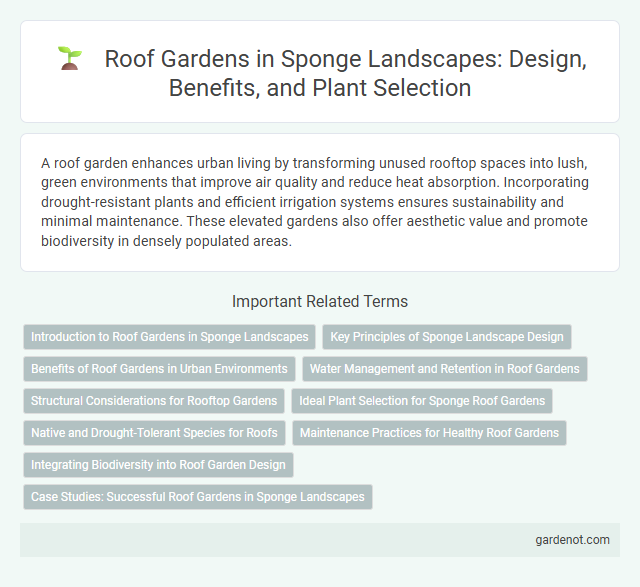A roof garden enhances urban living by transforming unused rooftop spaces into lush, green environments that improve air quality and reduce heat absorption. Incorporating drought-resistant plants and efficient irrigation systems ensures sustainability and minimal maintenance. These elevated gardens also offer aesthetic value and promote biodiversity in densely populated areas.
Introduction to Roof Gardens in Sponge Landscapes
Roof gardens in sponge landscapes serve as vital green infrastructures that manage stormwater by capturing and filtering rainwater, reducing runoff, and enhancing urban biodiversity. These gardens integrate absorbent soil layers and native vegetation to optimize water retention and promote natural infiltration, alleviating pressure on drainage systems. Incorporating roof gardens supports sustainable urban development by improving air quality, lowering urban heat island effects, and providing aesthetic and recreational benefits.
Key Principles of Sponge Landscape Design
Roof gardens in sponge landscape design prioritize water absorption and retention through the use of permeable substrates and drought-resistant plants. Incorporating layers of soil, vegetation, and waterproofing materials ensures efficient rainwater management while promoting biodiversity. These gardens reduce urban runoff, mitigate heat island effects, and enhance ecosystem services within built environments.
Benefits of Roof Gardens in Urban Environments
Roof gardens significantly enhance urban environments by reducing stormwater runoff and mitigating the urban heat island effect through increased vegetation coverage. These green spaces improve air quality by filtering pollutants and provide natural insulation, leading to lower energy consumption in buildings. Furthermore, roof gardens promote biodiversity and offer recreational spaces, fostering mental well-being and social interaction in densely populated cities.
Water Management and Retention in Roof Gardens
Roof gardens play a critical role in urban water management by capturing and retaining rainwater through permeable soil layers and vegetation, reducing runoff and mitigating flood risks. Advanced water retention systems integrated into green roofs improve stormwater absorption, promoting groundwater recharge and decreasing pressure on municipal drainage infrastructure. Efficient irrigation techniques and drought-resistant plants further enhance water conservation, optimizing the sponge landscape's sustainability benefits.
Structural Considerations for Rooftop Gardens
Structural considerations for rooftop gardens prioritize load-bearing capacity to support soil, plants, and water retention systems. Reinforced roofing materials and waterproof membranes prevent damage from moisture and root penetration. Proper drainage systems are essential to avoid water accumulation and maintain the structural integrity of the sponge landscape roof garden.
Ideal Plant Selection for Sponge Roof Gardens
Ideal plant selection for sponge roof gardens emphasizes drought-tolerant, native species that enhance water absorption and reduce runoff. Succulents, sedums, and deep-rooted grasses optimize sponge effect by retaining rainwater while thriving in shallow soil layers. Incorporating diverse plants with high evapotranspiration rates improves overall stormwater management and biodiversity on sponge roofs.
Native and Drought-Tolerant Species for Roofs
Native and drought-tolerant species such as sedum, agave, and lavender thrive in roof garden environments by conserving water and reducing maintenance needs. These plants improve urban biodiversity and enhance green infrastructure resilience by promoting natural rainwater retention and reducing heat island effects. Incorporating native species adapted to local climate conditions ensures sustainable greening of rooftops, supporting sponge landscape goals.
Maintenance Practices for Healthy Roof Gardens
Regular irrigation, soil quality monitoring, and proper plant selection are essential maintenance practices for healthy roof gardens. Implementing efficient drainage systems prevents waterlogging and structural damage while controlling pests and diseases ensures plant vitality. Consistent pruning and nutrient management contribute to sustained growth and aesthetic appeal in sponge landscape roof garden designs.
Integrating Biodiversity into Roof Garden Design
Integrating biodiversity into roof garden design enhances urban ecosystems by providing habitats for pollinators, birds, and beneficial insects. Native plant species, layered vegetation, and water features increase ecological value while improving air quality and stormwater management. Thoughtful selection of diverse flora supports local wildlife and contributes to the resilience of sponge landscape systems.
Case Studies: Successful Roof Gardens in Sponge Landscapes
Case studies of successful roof gardens in sponge landscapes highlight innovative designs that enhance urban water management and biodiversity. Notable examples include Singapore's Marina Bay Sands, which integrates extensive greenery to absorb rainwater and reduce runoff, and Copenhagen's Green Roof Project that combines native plants to improve stormwater retention. These projects demonstrate the effectiveness of roof gardens in mitigating flooding, improving air quality, and promoting ecological balance in densely built environments.
Roof garden Infographic

 gardenot.com
gardenot.com